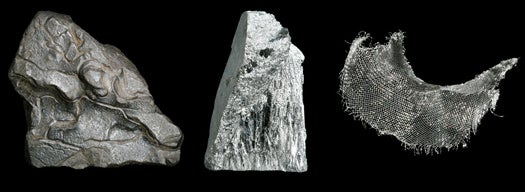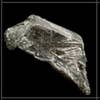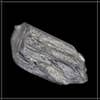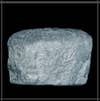A Guide To Our Diminishing Stockpile of Crucial Periodic Table Elements
The planet has limited resources of several important elements, many of which can do what no other element can. Here's what's left of the periodic table, and what would happen if we run out

Most congresspeople probably haven’t thought about chemistry since high school, but they’ll soon have to in order to protect the economy. In March, Colorado representative Mike Coffman introduced a bill to ramp up mining of 17 “rare-earth” elements, so called because large deposits of them are hard to find. Some are essential for electric auto motors and laser defense systems, and with demand for those rising, now is the time to stock up.
Launch the gallery here
Rare-earths combine particularly easily with other elements to form useful compounds and alloys, such as neodymium-iron-boron, the strongest, lightest magnet for motors. “No other element can do that,” says Jack Lifton, an independent metals consultant. “Once we’ve used them up, the periodic table is closed for business.” Similar stories are playing out across the table. For many elements, we’ll eventually need to find more, recycle, or move on to another. Launch the gallery for a status report for 10 of them.

Lithium
Cost: $2 per pound
Critical for: Batteries
Outlook: Strong
Every year, industries use nearly 20,000 tons of lithium, including some for lithium-ion batteries in electronics and electric hybrid cars. Even facing major demand, experts say, new mines will be able to keep up. *Reserves: Quantity of material that could be extracted from known deposits using current mining technology, as reported by the U.S. Geological Survey

Strontium
Cost: $0.03 per pound
Critical for: Red fireworks
Outlook: Good
No other element could make fireworks glow as intensely red. Demand for strontium should fall as users switch from cathode-ray tubes in old-style monitors to flat-panels that use much less of the element. And there’s plenty in the ground and oceans for every Fourth of July to come.

Tantalum
Cost: $40 per pound
Critical for: Capacitors for gadgets
Outlook: Fair
In 2000, speculation in the personal-technology market caused a 14-fold spike in prices of tantalum, a rare metal used in capacitors for cellphones and other gadgets. It fueled armed conflict in the Democratic Republic of Congo, which has the best deposits of this element. At some point in the future, manufacturers might be forced to switch to less-efficient aluminum or ceramic capacitors.

Neodymium
Cost: $28 per pound
Critical for: Electric motors
Outlook: Poor
This irreplaceable rare-earth metal is used to make light, powerful magnets in motors in cars, hard drives and wind turbines. Lack of Neodymium could be a limiting factor in the adoption of green technology, such as gearless wind turbines. It’s also used in military lasers for targeting and communications. Even though there are about 100 million tons of it in reserves, rising demand means the U.S. needs to scout out more deposits and improve extraction techniques for mixed ores.

Iron
Cost: $0.03 per pound
Critical for: Making steel
Outlook: Strong
Iron is the cheapest and most commonly used metala€”about 2.5 billion tons are mined a year. It’s heavier than aluminum, but it’s five times as cheap and strong enough for most jobs. And recycling is a breeze: Just smelt and recast.

Platinum
Cost: $17,000 per pound
Critical for: Fuel cells
Outlook: Fair
Roughly 200 tons of new platinum is put to work every year, mainly to strip toxins from exhaust in catalytic converters. But car fuel cells would use about 100 times that amount. If fuel cells take off, carmakers might have to move on to less effective catalysts, such as palladium.

Silicon
Cost: $1.20 per pound
Critical for: Computer chips
Outlook: Very strong
The second-most-abundant element in the Earth’s crust, after oxygen, silicon is a convenient, if less effective, substitute for rarer elements. While a lot of silicon goes into producing iron and aluminum alloys, high-purity silicon is used to make semiconductor chips for computers and photovoltaic cells for the solar industry.

Phosphorus
Cost: $0.04 per pound
Critical for: Fertilizer
Outlook: No worries
Crops can’t survive without phosphorus, so Americans use about 4.6 million tons of the element in fertilizer every year. It is then eatena€”and excreteda€”by people and animals. Because of concerns about phosphorus from sewage-treatment plants polluting waterways, experts recommend extracting the element from waste.

Tellurium
Cost: $66 per pound
Critical for: Solar cells
Outlook:Fair
Almost all tellurium is found as a trace element in copper ore, and very little can be recycled. No other element turns sunlight into electricity as well, and solar cells using tellurium semiconductors are inexpensive. If the tech proliferates, manufacturers might have to move on to less-efficient or pricier elements, such as selenium.

Helium
Cost: $0.14 per cubic foot
Critical for: Coolant for particle accelerators
Outlook: Fair
Helium has the lowest boiling and freezing points of any element, making it invaluable as a coolant in superconductors, particle accelerators and nuclear reactors. Experts recommend conserving and recycling helium, and efforts have included reusing Helium from the Macy’s Thanksgiving Day Parade balloons.